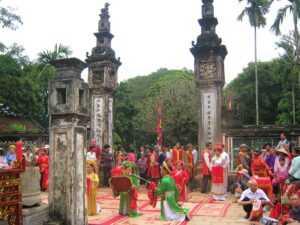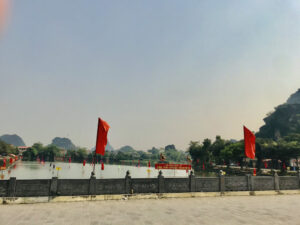Vietnamese culture respects family and ancestor worship as essential values for the nation’s establishment and continuity. People especially regard filial piety highly and use it to evaluate a person’s morals and character. The Hoa Lư Festival celebrates these traditional cultural traits.
The annual celebration honors national hero Dinh Bo Linh, the renowned Emperor who united the country into Dai Co Viet and founded Vietnam’s first feudal dynasty. Due to their close association, the Festival also pays homage to the tremendous contribution of King Le Hoan, King Dinh’s successor who presided over the subsequent early Le dynasty.
When it comes to Vietnam’s history, there is no shortage of pivotal dates, heroic deeds and critical events to revere. However nothing compares to the ascendancy of Dinh Bo Linh to King Dinh Tien Hoang and the formation of the inaugural Dinh Dynasty.
A Celebration of Independence
The Hoa Lu Festival holds the preeminent position among Ninh Binh celebrations and commands reverence throughout Vietnam. Vividly showcasing King Dinh Bo Linh’s life and career, as well as the cultural activities of the Dai Co Viet people of that era, it is also a colorful display of some of Vietnam’s oldest historical and traditional culture. A lot of fun mixed with pride at the founding Ancestors’ esteemed qualities of exchanging “blood and tears” for the country’s independence.
Hoa Lu was the capital of Vietnam’s first three feudal dynasties – the Dinh, the Early Le and the Ly. When King Ly Thai To relocated the capital from Hoa Lu to Thang Long (now the capital of Hanoi), the great reverence people had for Hoa Lu remained intact. Currently, the Hoa Lu Festival keeps aspects of the ancient folk arts alive and promotes the robust rural traits that are at the core of Vietnam’s phenomenal history. Increasingly recognized across the country, the Festival is fast becoming a “national” celebration.
The festival runs from the 6th to the 9th of the third Lunar month (late February to early March in the Solar calendar) and takes place at the Hoa Lu ancient capital relic site in Truong Yen commune, Hoa Lu district. It centers on the large area between the twin Dinh-Le temples in the Ancient City complex.
Note
Hoa Lu was renamed Truong Yen after the capitol of the Ly Dynasty was moved to Thang Long and for many years the festival was called the Truong Yen Festival. In 2016, it was renamed the Hoa Lu Festival by the government due to the ancient city’s significant cultural and spiritual influence on the development of the Vietnamese nation.
As mentioned, Vietnamese culture places great importance on reverence for family and reverence for ancestors. Therefore, celebrating the lives and strictures of those who came before is considered a moral and noble obligation. The origin of those great ancestors is also considered important and people believe that the Hoa Lu Festival is also celebrates Truong Yen as land of “human genius” and a large part of the reason for the success of their long struggle for peace and independence.
The National Ceremony
Historical records describe the Hoa Lu festival as a ‘solemn ceremony,’ and successive Vietnamese dynasties later regarded it as ‘the Nation ceremony,’ even though Hoa Lu was no longer the capital. The courts of Thang Long-Hanoi through to the Nguyen dynasty of Hue all sent high mandarins and officials to the Truong Yen/Hoa Lu Festival.”
According to legend, King Dinh’s birthday is on the 15th of the second lunar month, but the people of the ancient capital Hoa Lu instead celebrated the day the king ascended the throne around March 6-7 on the lunar calendar. King Le Hoan, the founder of the Early Le Dynasty, died on March 8, so people traditionally hold the festival during the following three days. A coincidence of history perhaps but for such a large undertaking, it has turned out extremely convenient.
Ancient Conventions
The festival divides into two main parts: the sacrifice and the festival. The sacrifice breaks down into seven categories: the temple door opening ceremony, the water procession ritual, the incense offering ceremony, the fire procession, the Moc Duc ceremony, the donation ceremony, the palanquin procession, and the Floating Lamp (water lantern). The festival itself includes four sections: an opening ceremony, a reed flowers chess drill, Thai Binh letter sorting, and other festival-related events.
The ritual begins with the Moc Duc ceremony, which is the statue’s “bathing” rite (held at midnight the night before the festival begins). Moc Duc is the traditional Vietnamese rite of washing a corpse before burial, but many Asian ceremonies also use it symbolically to cleanse artifacts, statues, and other representations of the long deceased
Participants then wash the tablets and prepare headgear for the statues, all to get ready for the ceremonial palanquin procession of the ‘royal statue’ to the temple. The palanquin usually only carries the king’s tablet and cap. Esentially, the Moc Duc is about preparing revered ancestors for their public parade.
During the Hoa Lu Festival, people actively participate in the procession by burning incense, offering prayers, and reading vows passed down from generations. This pays respect to the talented heroes of the country and also as an offering of worship to both heaven and earth. At the end of the “water procession,” everyone gathers in the center of the stage to start the fire procession by burning incense sticks and candles at King Dinh and King Le’s shrines. As part of the Tribute Ceremony, judges hold a contest between the participating teams to select the most beautiful Five Fruit Trays, deciding which ones are most fit to worship the kings of both temples.
The Palanquin Procession
For the “Palanquin procession”, the parade begins in the heart of Hoa Lu’s old capital and concludes at the twin temples. People say this ritual demonstrates respect, admiration, and loyalty to the wise men who ‘laid a firm foundation’ for modern Vietnam’s culture. Finally, Buddhist monks, nuns and fellow believers light water lanterns to release on the Sao Khe river, somewhat similar to the Vu Lan (Hungry Ghost) lanterns of Hoi An in Central Vietnam. This ceremony usually begins at 19:00 and lasts until 23:00 on the same day.
The Water Procession
Participants follow the procession with the ‘temple opening’ ritual at King Dinh Tien Hoang’s and King Le Hoan’s temples. During the event, guests can visit the temple without needing to show their entrance tickets as is customary. The ‘water procession’ follows, starting at King Dinh Tien Hoang’s temple and proceeding to the Hoang Long river dock, where participants collect water in a cup and return it to the temple.
The meaning of “the water procession” has a deep significance in local culture, expressing appreciation to the god in the Four Immortal mascots of Vietnam. People say that the ‘Golden Dragon’ sometimes appears in the river to assist.The ‘Fire Procession’ begins after the ‘Water Procession’ concludes. In general, this begins with a fire lit in King Dinh’s hometown in Gia Phuong commune, Gia Vien district, Ninh Binh province, and ends at the twin temples in Truong Yen commune, Hoa Lu district.
Entertainment
The opening ceremony takes center stage, and visitors can enjoy the musical “cultural legacy” of Vietnam, such as Cheo and Xẩm singing, among other things. Each “story” describes a new chapter in the nation’s history. From the establishment of the Dai Co Viet state to the defeat of the Song Dynasty army, the expansion of the territory to Champa, and the relocation of the capital to Thang Long citadel, Hanoi. Best advice here is to have a friend or guide who can explain what is happening.
The most famous event is “the traditional spiritual specialty of the Hoa Lu mountainous area” which is the stage of “the rehearsal reed flowers chess excise”. This popular selection depicts King Dinh Bo Linh’s boyhood story and explains how he unified the 12 warlords to construct Dai Co Viet’s centralized empire. There is also a folk game of sorting letters called “Thai Binh” and other activities for guests to enjoy.
Cultural Enrichment
Cultural practices are a vital for the development and construction of human society, and every country around the world preserves and promotes their “golden values”, giving each nation its own individuality. Hoa Lu Festival expresses the identity of a nation that has been yearning for independence and wealth since inception and describes the various “markers” of that journey. It’s also a symbol of the bright future that awaits future generations. Regardless of all the changes, it reminds and celebrates a nation born from “the dragon and the fairy.“.




